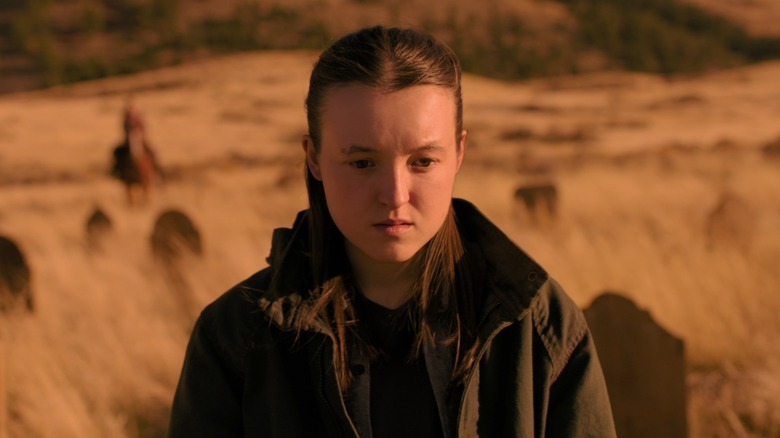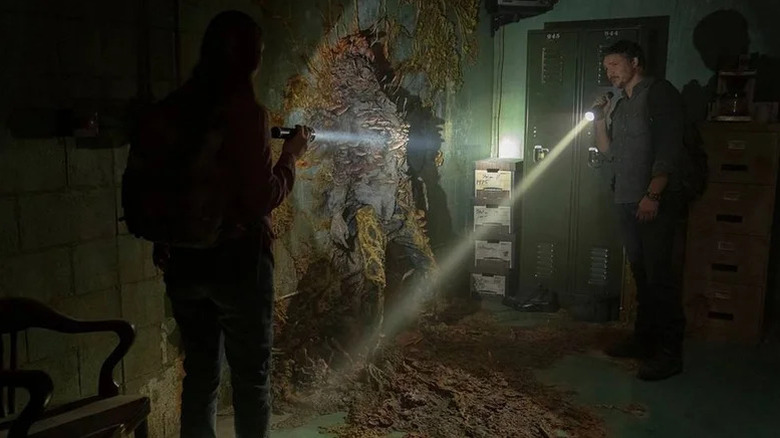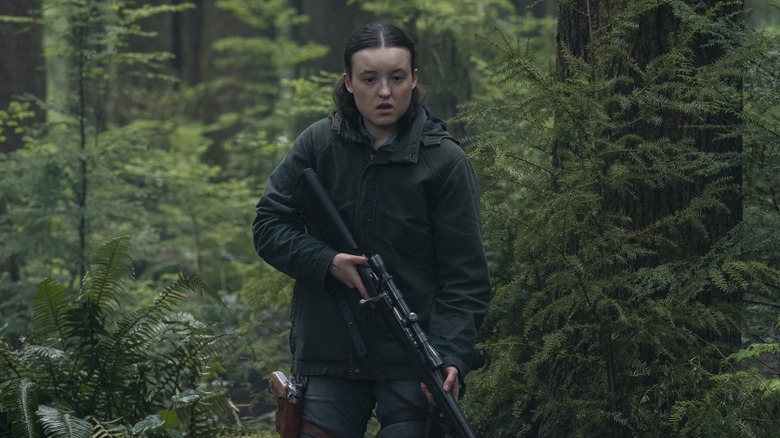The Last Of Us Season 2 Episode 5 Finally Introduces A Key Threat From The Original Games
This article contains spoilers for "The Last of Us" season 2, episode 5.
The Cordyceps brain infection is fairly straightforward. Both in "The Last of Us" games and on the show, it got its origin from tainted crops but soon started spreading on its own, courtesy of infected individuals. After this initial infection, the poor person with the mutated Cordyceps now growing in their brain is slowly taken over, leading them to a hellish life cycle of various types of Infected zombies on "The Last of Us."
Up to now, however, the show has omitted a key component of the Cordyceps infection. In the games, all non-immune characters have to keep a gas mask ready whenever they're exploring confined areas in case they stumble upon a spot where the air is contaminated by Cordyceps spores. Breathing them in is a surefire way to become infected, which makes the spores a dangerous (and fairly common) environmental threat.
In all likelihood, HBOs "The Last of Us" has opted to skirt around the spore situation for the sake of economic storytelling economy, much like there are far fewer direct encounters with Infected than in the games. But season 2, episode 5 forces the show's hand. This is where the plot progresses to a point where the Cordyceps spores simply can't be avoided if the series wants to faithfully adapt the big beats of Ellie's (Bella Ramsey) revenge mission in Seattle. "The Last of Us" season 2 chooses accuracy, and as a result, Ellie's chilling encounter with Nora (Tati Gabrielle) introduces the spores in the show's ever-spreading Cordyceps lore.
The Last of Us season 2 gives the games' biggest spore scene a faithful adaptation
The video game version of the encounter in "The Last of Us Part II" kicks off when Ellie (Ashley Johnson) infiltrates the Lakehill Seattle Hospital to encounter Nora (Chelsea Tavares), a former Firefly medic who has joined the Washington Liberation Front and was part of Abby's (Laura Bailey, played by Kaitlyn Dever on the show) mission to kill Joel (Troy Baker in the game, Pedro Pascal on the show). After a tense face-off and a desperate chase through the corridors, the pair end up in a contaminated area where the air is rife with spores. This, of course, doesn't bother the immune Ellie. On the contrary, she turns the situation into an interrogation tactic, promising to kill Nora and thus spare her from turning into a zombie in exchange for information.
This scene, particularly Nora's death at the end of it, marks a pivotal moment in Ellie's character arc because while it's not the first time she kills a human being, it's the first time self-defense isn't involved. In one way or another, the Nora chase was always going to be an integral component of the season. But it's worth noting that the show finds a way to both have its cake and eat it, too.
The episode depicts the core components of the chase and its gruesome aftermath with almost surprising accuracy, going as far as throwing in some extra-gruesome imagery in the shape of an infected WLF soldier stuck in the wall. On the other hand, the spore-infested area is framed as something of an anomaly, which gives the show an opportunity to go back to ignoring the concept after this, should it so desire. After all, even though its hand was forced for this particular scene, "The Last of Us" is overall just fine without spores.
The show's Cordyceps is more dangerous and versatile than in the games
It's understandable that the HBO show wants to avoid cluttering its episodes with spore-infested areas. After all, even an adaptation as faithful as "The Last of Us" has to take considerable liberties simply because video games and TV shows are such different mediums. In some ways, the show has been accurate about the Cordyceps life cycle, while in others, it's added its own spin on things.
The games' version of the infection is a well-established life cycle that takes the victim from a recently-infected Runner stage to the fiendish, strategic Stalker stage and the fearsome, blind Clicker stage. The precious few who endure beyond that will reach the rare, hulking Bloater or Shambler stages, depending on the moisture conditions of the area they haunt. The show largely matches this, introducing the terrifying Stalker stage in "The Last of Us" season 2 despite it briefly appearing in the first game, and the show's characters treat it as a new and terrifying threat, implying a mutation of some sort.
But a show invention is the way Runners spread the Cordyceps brain infection with tendrils that extend from their mouths. The season 1 episode "Infected" introduced the concept of the Boston-area Infected being a hive mind that's able to pinpoint uninfected people with sensitive fungal tendrils. Season 2 even brings back that concept with a vengeance in the shape of the Cordyceps that hides in a pipe and summons the Infected armies to attack the survivor settlement of Jackson, Wyoming. All in all, the show has been building such an impressive arsenal of ways it can expand on its Cordyceps lore that it might actually be better to avoid complicating things further with regular spore sightings.
"The Last of Us" season 2 continues with a new episode next Sunday night on HBO and Max.


